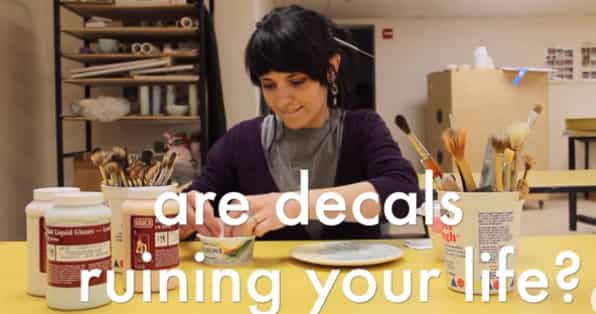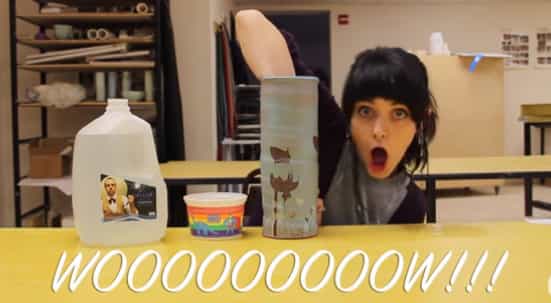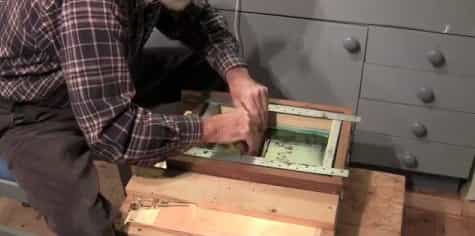
It is a unique process of painting a design on fil-coated decal paper. The decal is dried and transferred the film on a fired ware. Decals are very simple designs. They get moved to ceramic surfaces, making them look beautiful and appealing. They add an elegant appearance to ceramic surfaces. They make them look unique. In this article, we’re going to share how to make ceramic decals step by step.
The most common type of decals used is ceramic decals nowadays. It has mostly two types. The over-glaze and water slide decals. Ceramic decals are a frequently used technique. We used decals for ornamental purposes.
Why we need ceramic decals?
We used them to decorate the stoneware, cups, earthenware, and other common use materials. The ceramic decals have offered a variety of designs. They are used for decorations. Verity of colors is available in the market. They are blended to make beautiful designs that later get pasted on the ceramic surface.
It gives a beautiful appearance. Ceramic decals have a pretty impressive nature. They greatly enhance the brand and looking of brands, making them unique. They are now frequently being used in pottery and artistry. The customer will have a variety of ware according to their taste.
Adding decals to ceramics will increase the sales on boost. Ceramic pottery already has favoritism by people. It is due to its tremendous qualities. When decals are installed, it makes it even more popular to use.
DIY ceramic decals:
If you are tired of using commercial decals, then you can put effort into creating your own. You can even create decals of your favorite quotes and designs. You can take a break, and you are going to need the things mentioned below for the creation of your decals.
- Over-glaze colors
- Ceramic decal printer/color
- Polyurethane varnish
- Scissors
How to make ceramic decals step by step guide
Mixing:
The first step is to take the desired color. The color selection is very important as the whole procedure is based on the ornamental purpose. Took the colors and mixed them well. They can be mixed in any pot with a brush for mixing. Mixing should be uniform, and there should be no solid entity left in color mixing.
Creating the pattern: Selection of the pattern is important. Different patterns and designs can be seen on the internet. Choose a design according to your taste and nature. You can blend the designs to make it even good.
· Over-glaze colors:
Next step is to place your glazing material onto the pattern you just created. For this purpose, use a squeegee. A brush or a soft cloth can be used for this purpose. You can do this by yourself or also by some professional means. Remember the color you spread must be applied evenly on all surfaces on pattern and no place left uncolored.
- Pull the pattern: this step needs some extra attention. Very carefully pull the pattern away.
- Then give pattern stand and left it to dry.
· Polyurethane:
After the pattern is dry, use polyurethane varnish on all the patterns. Notice that the varnish fil has created the film on decal paper and print.
· Cutting:
Took scissors and cut the design carefully. Simple design is easy to cut, but complex shapes need to be cut very carefully.
Steps to apply decals on ceramic
The making of decals and applying these decals on ceramic surfaces like ceramic tiles, cups, plates, bowls, and whatever you want to apply are different things. Whether you buy decals or make them yourself, remember to use them correctly. We will discuss how you use decals on the step of the ceramic surface by step.
1. Cleaning the piece:
The first step is to apply the decals in cleaning your ceramic surface. You can apply many methods to clean the surface. The simple one is using the water. Make the water warm or a little hot on the stove, don’t make the water super-hot.
After this, take a clean cloth, and dip in hot water for one minute. When the water had soaked enough water to clean the material, it took it out and wiped the ceramic. There is no leftover debris or dirt. Debris and dirt disturb the pasting of the design and leave the air spaces on the surface while pasting the design. You can even use alcohol to clean the surface.
2. Trim the decal:
Trim the decal and soak in lukewarm water. It is a delicate process because it demands experience and extra observation. While the paper is in water, you will notice that the paper’s edges will start peeling off.
The decal shape may twist or curl, but you don’t have to be worried, be patient, and your decal will become straight again after a little while. Many people ask about are criteria to take the paper off from the water so here is the answer. If the backing of decals slips easily, then it’s time to remove the decals from the water. In case the backing doesn’t peel off, then place the decal on a towel and give it some rest.
3. Moisten the ceramic piece:
The ceramic surface is once again cleaned with a dry cloth. In all processes, one should be conscious about cleaning because it is the base of everything. If it is not cleaned properly, there will be spaces left over. Now lay an edge of decal over the ceramic surface carefully. Slide the paper backing away, leaving the decals just right there.
4. Removal of air:
The next step involves the removal of air or water that is beneath the decals. A damp sponge is used to do this process with ease and efficiency. Blot dry paper towels work well to remove the water particles.
If any water particle or air bubble is left underneath, the decals will disturb the sticking. The whole effort will be lost, so be careful about removing such entities and paying extra attention. In case the bubble is left beneath the decals, take a pin, pick the decal, place some water under it to smooth the surface with water again.
5. Re-firing the ceramic:
The finals step involves the re-firing of the ceramic. Work well to re-fire the ceramic to about cone-15. It is almost equal to 1540n degrees. For this temperature, a kiln can be used. In case you don’t have a kiln or any temperature source, then no need to worry. You can even use the decals without it. The after-care step involves spraying your piece.
After you have successfully pasted the decal on your piece, cover the surface with a spray sealer. If you have painted the piece with the acrylic spray, then you must use a sealer and then transfer the paper to the ceramic surface.


I need sources and more info how to do this. Printer?
Ink? Paper?
Where do you get this stuff????